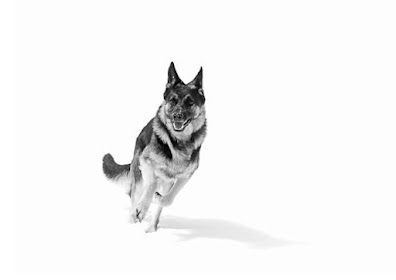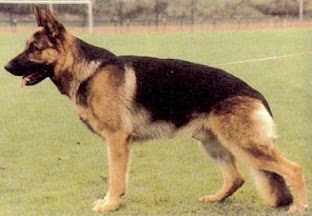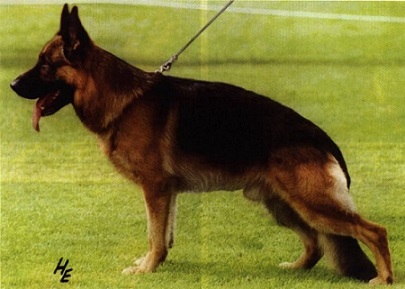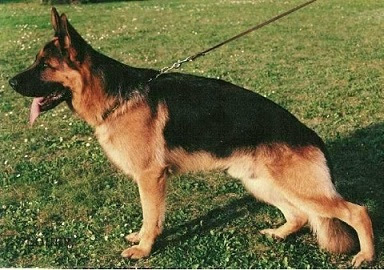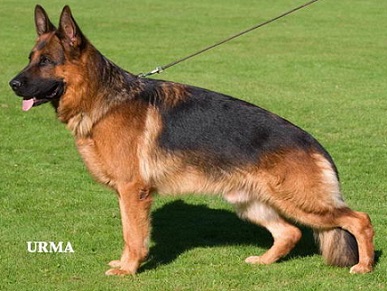German Shepherd Dog History - Years of Special Occurrences, which has been considered as Time Map of GSD History in this post.
Here is the detailed time map in the history of German Shepherd Dog breed since the start
1891 - Phylax Society was formed. With very short life span, this dog club was a precursor to the Verein fur Deutsche Schaferhunde (S.V), which was later created by Max von Stephanitz, the originator of GSD breed.
1894 - The Phylax Society (that was formed in 1891) was disbanded. Many members of the Phylax Society continued to exhibit the ideologies and concepts formulated by the society. One of those eminent members was "Captain Max von Stephanitz", the man who has been credited with the honor of being the father of German Shepherd Dog breed.
1895 - Hektor Linkshrein - later renamed as Horand von Grafrath was born on January 1st
1899 - Verein fur Deutsche Schaferhunde (S.V.) was initiated.
1899 - On April 3rd in the same year of the formation of the Verein für deutsche Schäferhunde (SV) - world's first All-Breed German Dog show was held in Karleruube Rhineland. Captain Stephanitz, and his friend, Arthur Meyer were present in the show looking for a perfect dog to create a really superb herder. Captain Stephanitz fell in love with a dog called Hektor Linkshrein and purchased the dog right at the spot with 200 deutsche mark and this turned out to be the major turning point in the History of German Shepherd Dog evolution.
1901 - The world's first Schutzhund (also used to be known as IPO and presently know as IGP) trial was held in Germany in the year 1901. The dogs were for abilities in tracking, obedience and protection. The Schutzhund sport was developed in Germany as a suitability test for the GSD breed, but later included other breeds.
1906 - First German Shepherd Dog that was believed to have set paws upon North America. The name of the dog was Queen of Switzerland. However, most of her progenies came up with defects due to wrong breeding. This impacted the breed's popularity adversely during the late 1920s in America.
1907 - The first German Shepherd Dog ever exhibited in America.
1908 - The first German Shepherd registered with the American Kennel Club (AKC).
1908 - German Shepherd Dog first arrived in Great Britain in the early part of the century during this phase of time.
1913 - Benjamin Throop and Anne Tracy formed the German Shepherd Dog Club of America with 26 charter members.
1913 - The first championships had been awarded to German Shepherd Dogs.
1914 - Since this phase of time till the decline of WW I, the heroic German Shepherd Dogs served in World War I and had played a salient role in the war.
1915 - The first specialty show of the German Shepherd Dog Club of America was held at Greenwich, Connecticut.
1917 - When America entered World War I, all things related to Germany became tabu. The American Kennel Club (AKC) changed the name of the GSD breed to the "Shepherd Dog". thus the German Shepherd Dog Club of America (GSDCA) became the "Shepherd Dog Club of America". In England, the breed had been renamed to "Alsatian". Read out the history of German Shepherd name.
1918 - Rin-Tin-Tin (Rin Tin Tin, Rinty) was born on September 10, as a Dark Grey male baby. He was sired by Fritz de la Chasse royale, who had been traced to the first Registered German Shepherd Dog, Horand. Rinty's mother was Betty des Flandreswho had also been traced to the first Registered German Shepherd Dog, Horand. Rinty was owned by Lee Duncan an american Serviceman.
1919 - The English Kennel Club (UK Kennel Club) gave the GSD breed a separate register with 54 dogs being included. By 1926 the count had swelled to 8,058. Such was the exceptional success of the German Shepherd Dog.
1920's - The "Alsatian League" and the "Alsatian Wolf Dog Club" united in the early 1920's under the name of the Alsatian League and Club of Great Britain and started bringing out some order to the GSD
1921 - "Strongheart" - the German Shepherd Dog became the first canine movie GSD star in silent movie, although there were a few canine stars (apart from GSD) had appeared before Strongheart. In 1921 strong acted in his first movie named "The Silent Call". Strongheart became the favorite star and had been well acclaimed by moviegoers of all ages. He used to travel by train from one part to the other of the country and huge mobs of people were on hand to see this marvellous animal at almost all stations.
1921 - Adolf Hitler adopted a female German Shepherd Dog - named "Prinz", during his years of poverty. Hitler was forced to keep Prinz elsewhere, but she escaped and ran back to Hitler. Hitler liked the breed's loyalty and started developing very strong liking for GSD.
1922 - Strongheart starred in the movie called "Brawn of the North". 1924 - Strongheart starred in the movie called "The Love Master".
1923 - The Verein für Deutsche Schäferhunde declared that the organization has a ground breaking number of 50,000 paid members in more than 500 branches in Germany alone.
1923 - German Shepherd Rin Tin Tin becomes a canine film star.
1923 - Shepherd Dog Club of New England founded, publishing the Shepherd Dog Review.
1925 - Strongheart starred in the movies called "White Fang" and "North Star".
1925 - The titles of Grand Victor and Grand Victrix are established as the titles for the winners of the GSDCA National.
1927 - Strongheart starred in the movies called "The Return of Boston Blackie"
1928 - Buddy, a German Shepherd Dog, becomes the first Seeing Eye dog among other service dogs to follow in the GSD timeline.
1932 - Rin Tin Tin (lovingly called "Rinty") died on August 10, at the age of 14 years in Los Angeles in the arms of the famous actress Jean Harlow. Rinty's owner had arranged to have Rinty's dead body returned to his birth land - Lorraine, France for his burial in the Cimetière des Chiens, the famous pet cemetery in the Parisian suburb of Asnières-sur-Seine. "Rin Tin Tin" was honored with a star on the "Hollywood Walk of Fame" at 1623 Vine St. in Hollywood, Los Angeles, California, USA, that serves as an entertainment museum.
1936 - Max von Stephanitz, the founder of the German Shepherd Dog breed, died.
1937-38 - The German Shepherd named Pfeffer von Bern (SGR 1937/8GV CH (US)) won as Grand Victor the 1937 American Kennel club dog show. This resulted as huge boost in the GSD breed's popularity in the USA, that was badly declined due to defective progenies (breeding defects) of Queen of Switzerland (the first dog to land in the US in 1906)
1941 - Adolf Hitler was gifted the second girl German Shepherd by Martin Bormann (German Nazi Party official and head of the Nazi Party Chancellery). Hitler was very fond of Blondi and kept her even after he moved into the Führerbunker located underneath the Reich Chancellery garden.
1945 - Adolf Hitler German Shepherd, Blondi died on April 30. Hitler wanted to check the potency of the cyanide capsules given by Heinrich Himmler. He tested on Blondi, as a result Blondi expired.
1967 - On June 23, 1967, Air Force Headquarters directed that Nemo, the 85 pound, black and tan German Shepherd, was the first hero of his kind to return from the Vietnam War. He returned to the United States with honors, as the first sentry dog to be officially retired from active service.
1977 - This year the British Kennel Club (being pressured by strong campaign by GSD enthusiasts) registered the breed back to it's name "German Shepherd Dog". But the breed was registered as the German shepherd Dog "Alsatian". The name "Alsatian" appeared within parenthesis till 2010.
Spanning back to the related history, after the WW I it was believed that because of the anti-German sentiment of the time, the word "German" being included in the breed's name might result the popularity of the breed to suffer a fall. Hence the breed was renamed as "Alsatian Wolf Dog" by the British Kennel Club. This name was kept after the border region area of “ALSACE -- LORRAINE”. However, it was again feared the presence of the appendage "wolf dog" could also impact the breed's popularity, as people might "wrongly" think that there's direct wolf's gene in this breed that would make the breed dangerously aggressive. Hence, the appendage "wolf dog" was eliminated and the breed was renamed as "Alsatian" and remained as Alsatian until the year 1977.
2010 - This year was also a vital year in the history of this breed. The final renaming of the breed from (German Shepherd Dog "Alsatian") to just (German Shepherd Dog) was officially declared in 2010. This means as the full name, the word "Alsatian" within the parenthesis that used to be mentioned since 1977 after German shepherd Dog was finally removed the breed was renamed as German Shepherd Dog in 2010.
Read more...



.png)
.png)





